Notes
- ↑ Swensson, Andrea (October 10, 2017). "The Family". Got to Be Something Here: The Rise of the Minneapolis Sound. University Of Minnesota Press. ISBN 9780816632336.
Back to Black | |
|---|---|
| Origin | Minneapolis, Minnesota, United States |
| Genres | |
| Years active | circa 1972 |
| Associated acts | |
| Members | Randy Barber
* Sonny Thompson
|
Back to Black was a band formed in Minneapolis around 1970. They changed their name to The Family, a name later adopted by Prince for The Family. They were the house band at The Way community center, and performed at the Phyllis Wheatley Community Center (both now demolished). Prince considered them a lifelong influence. Their bassist, Sonny Thompson, worked with Prince in the New Power Generation from 1991 to 1996. [1]
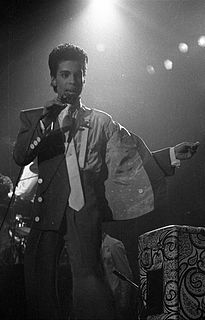
Prince Rogers Nelson was an American singer-songwriter and multi-instrumentalist. Widely regarded as one of the greatest musicians of his generation, he was known for his flamboyant, androgynous persona and wide vocal range, which included a far-reaching falsetto and high-pitched screams. Prince produced his albums himself, pioneering the Minneapolis sound. His music incorporated a wide variety of styles, including funk, R&B, rock, new wave, soul, synth-pop, pop, jazz and hip hop. He often played most or all instruments on his recordings.

Hennepin County is a county in the U.S. state of Minnesota. Its county seat is Minneapolis, the state's most populous city. The county is named in honor of the 17th-century explorer Father Louis Hennepin. The county's eastern side is influenced by Minneapolis with its financial and manufacturing activity. The western side of the county is mostly suburbs and rural communities, along with some farms, covered with extensive woods, hills, and lakes.

Minneapolis–Saint Paul is a metropolitan area located around the confluence of the Mississippi, Minnesota and St. Croix rivers in the U.S. state of Minnesota. It is commonly known as the Twin Cities after the metro’s two largest cities, Minneapolis and Saint Paul. Minnesotans often refer to the two together simply as "the cities". It has the second largest economy in the Midwest.

Eden Prairie is a city 12 miles (19 km) southwest of downtown Minneapolis in Hennepin County and the 15th-largest city in the State of Minnesota, United States. As of the 2020 census, it has a population of 64,198. The city is adjacent to the north bank of the Minnesota River, upstream from its confluence with the Mississippi River.

Osseo is a small city in Hennepin County, Minnesota, United States. As of the 2020 census it had a population of 2,688.

Bloomington is a suburban city located in Minneapolis’s Hennepin County on the north bank of the Minnesota River, above its confluence with the Mississippi River. Bloomington is the fourth largest city, in the U.S. state of Minnesota. Bloomington lies 10 miles (16 km) south of downtown Minneapolis. As of the 2020 census the city's population was 89,987.
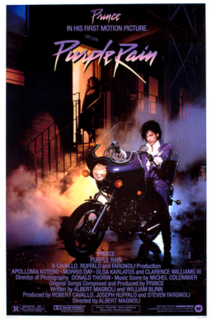
Purple Rain is a 1984 American rock musical drama film scored by and starring Prince in his acting debut. Developed to showcase his talents, it contains several concert sequences, featuring Prince and his band The Revolution. The film is directed by Albert Magnoli, who later became Prince's manager, from a screenplay by Magnoli and William Blinn. The cast also features Apollonia Kotero, Morris Day, Olga Karlatos and Clarence Williams III.

Target Center is a multi-purpose arena located in Minneapolis, Minnesota, United States. Opening in 1990, it hosts major family shows, concerts, sporting events, graduations and private events. Target Corporation, founded and headquartered in Minneapolis since 1902, is the original and current naming rights partner of the arena.
The music of Minnesota began with the native rhythms and songs of Indigenous peoples, the first inhabitants of the lands which later became the U.S. state of Minnesota. Métis fur-trading voyageurs introduced the chansons of their French ancestors in the late eighteenth century. As the territory was opened up to white settlement in the 19th century, each group of immigrants brought with them the folk music of their European homelands. Celtic, German, Scandinavian, and Central and Eastern European song and dance remain part of the vernacular music of the state today.

Uptown is a commercial district in southwestern Minneapolis in the U.S. state of Minnesota, that is centered at the intersection of Hennepin Avenue and West Lake Street. It has traditionally spanned the corners of four neighborhoods, Lowry Hill East, East Bde Maka Ska, South Uptown and East Isles neighborhoods, which are all within the Calhoun Isles community. Historically, the boundaries of Uptown are Bde Maka Ska to the west, Dupont Avenue to the east, 31st Street to the south, and 28th Street to the north; though these borders often vary. Uptown is a popular destination for retail, nightlife, and cultural events, and the district was famously written about by recording artist Prince.
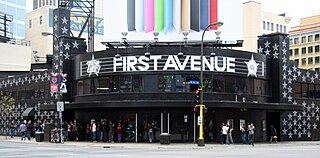
First Avenue & 7th St Entry are two music venues housed in the same landmark building in downtown Minneapolis, Minnesota. The names are derived from the building's location on the corner of First Avenue North and 7th Street North. The building is marked by 531 stars on its exterior commemorating past venue performers.
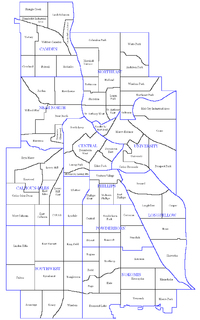
The U.S. city of Minneapolis is officially defined by the Minneapolis City Council as divided into eleven communities, each containing multiple official neighborhoods. Informally, there are city areas with colloquial labels. Residents may also group themselves by their city street suffixes, North, Northeast, South, Southeast, and Southwest.
Paul Joseph Peterson, also known as St. Paul Peterson, is a singer and musician best known for his memberships in the bands The Family and The Time.

The Time, also known as Morris Day and the Time and The Original 7ven, is an American musical group founded in Minneapolis in 1981. Their work has been a part of the formation of the Minneapolis sound, featuring a mix of soul music and dance music with funk, rock n roll, and more. Led by singer-songwriter Morris Day the band members are known for having been close Prince associates, and are arguably the most successful artists who have worked with Prince, achieving particular popularity with R&B fans with tracks such as "The Bird", "Cool", and "Jungle Love". Former members Jimmy Jam and Terry Lewis went on to a prominent production career after they left the band in 1983, while Day and guitarist Jesse Johnson recorded solo material in addition to their work with the Time.
Mille Lacs Indian Reservation is the popular name for the land-base for the Mille Lacs Band of Ojibwe in Central Minnesota, about 100 miles (160 km) north of Minneapolis-St. Paul. The contemporary Mille Lacs Band reservation has significant land holdings in Mille Lacs, Pine, Aitkin and Crow Wing counties, as well as other land holdings in Kanabec, Morrison, and Otter Tail Counties. Mille Lacs Indian Reservation is also the name of a formal Indian reservation established in 1855. It is one of the two formal reservations on which the contemporary Mille Lacs Band retains land holdings. The contemporary Mille Lacs band includes several aboriginal Ojibwe bands and villages, whose members reside in communities throughout central Minnesota.

The Revolution are an American rock band formed in Minneapolis, Minnesota and assembled in 1979 by Prince. Although widely associated with rock music, the band's sound incorporated rhythm and blues, pop, funk and psychedelia elements. Before their official breakup, the Revolution had released two studio albums, two soundtracks and two videos.
The Minneapolis sound is a subgenre of funk rock with elements of synth-pop and new wave, that was pioneered by Minneapolis, Minnesota based musician Prince in the late 1970s. Its popularity was given a boost throughout the 1980s thanks to Prince and groups he organized or produced and the offshoots from his band The Revolution, Wendy & Lisa and Brownmark. After leaving The Time, Jimmy Jam and Terry Lewis, Morris Day, Jesse Johnson all moved on to successful careers. Minneapolis acts not directly associated with Prince also utilized this musical style, including Ta Mara & the Seen, Mazarati, The Jets.

Minneapolis Community and Technical College is a public community college in Minneapolis, Minnesota. It has one of the most diverse student populations in the state and enrolls nearly 11,100 credit students annually. Minneapolis College is part of Minnesota State, which offers two-year associate degrees, certificates, and diplomas.
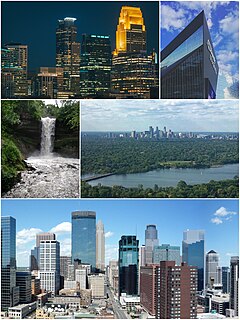
Minneapolis is a city in the U.S. state of Minnesota and the county seat of Hennepin County. Abundant in water, with thirteen lakes, wetlands, the Mississippi River, creeks and waterfalls, Minneapolis had its origins in timber and as the flour milling capital of the world. It lies along both banks of the Mississippi River and adjoins Saint Paul, the state capital of Minnesota.

Longfellow is a defined community in Minneapolis, Minnesota which includes five smaller neighborhoods inside of it: Seward, Cooper, Hiawatha, Howe and Longfellow. The community is a mix of agri-industrial properties along the old Northern Pacific Railway, expansive parkland surrounding the famous Minnehaha Falls, and smaller residential areas.